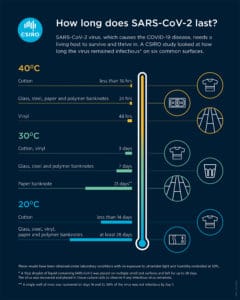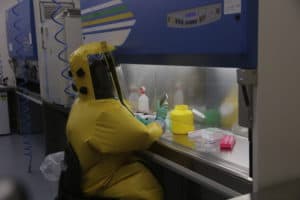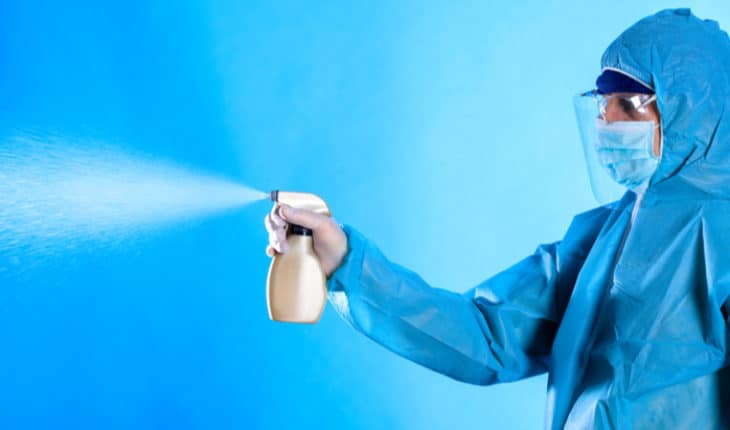CSIRO scientists publish new research on SARS-COV-2 virus ‘survivability’: COVID-19 causing virus lasts for 10 days longer than Influenza on some surfaces. Lower temps, glass, stainless steel and paper banknotes give virus longer life.
Researchers at CSIRO, Australia’s national science agency, have found that SARS-CoV-2, the virus responsible for COVID-19, can survive for up to 28 days on common surfaces including banknotes, glass – such as that found on mobile phone screens – and stainless steel.
The research, undertaken at the Australian Centre for Disease Preparedness (ACDP) in Geelong, found that SARS-CoV-2:
- survived longer at lower temperatures
- tended to survive longer on non-porous or smooth surfaces such as glass, stainless steel and vinyl, compared to porous complex surfaces such as cotton
- survived longer on paper banknotes than plastic banknotes.
Results from the study The effect of temperature on persistence of SARS-CoV-2 on common surfaces was published in Virology Journal.
CSIRO Chief Executive Dr Larry Marshall said surface survivability research builds on the national science agency’s other COVID-19 work, including vaccine testing, wastewater testing, Personal Protective Equipment (PPE) manufacture and accreditation, and big data dashboards supporting each state.
“Establishing how long the virus really remains viable on surfaces enables us to more accurately predict and mitigate its spread, and do a better job of protecting our people,” Dr Marshall said.
Dr Debbie Eagles is Deputy Director of ACDP, which has been working on both understanding the virus and testing a potential vaccine.
“Our results show that SARS-CoV-2 can remain infectious on surfaces for long periods of time, reinforcing the need for good practices such as regular handwashing and cleaning surfaces,” Dr Eagles said.
“At 20 degrees Celsius, which is about room temperature, we found that the virus was extremely robust, surviving for 28 days on smooth surfaces such as glass found on mobile phone screens and plastic banknotes.“ For context, similar experiments for Influenza A have found that it survived on surfaces for 17 days, which highlights just how resilient SARS-CoV-2 is.”
The research involved drying virus in an artificial mucus on different surfaces, at concentrations similar to those reported in samples from infected patients and then re-isolating the virus over a month. Further experiments were carried out at 30 and 40 degrees Celsius, with survival times decreasing as the temperature increased. 
“Together, we hope this suite of solutions from science will break down the barriers between us, and shift focus to dealing with specific virus hotspots so we can get the economy back on track.
“We can only defeat this virus as Team Australia with the best Australian science, working alongside industry, government, research and the Australian community.”
The study was also carried out in the dark, to remove the effect of UV light as research has demonstrated direct sunlight can rapidly inactivate the virus.“While the precise role of surface transmission, the degree of surface contact and the amount of virus required for infection is yet to be determined, establishing how long this virus remains viable on surfaces is critical for developing risk mitigation strategies in high contact areas,” Dr Eagles said.
Director of ACDP Professor Trevor Drew said many viruses remained viable on surfaces outside their host. “How long they can survive and remain infectious depends on the type of virus, quantity, the surface, environmental conditions and how it’s deposited – for example touch vs droplets emitted by coughing,” Professor Drew said.
“Proteins and fats in body fluids can also significantly increase virus survival times.”
The research may also help to explain the apparent persistence and spread of SARS-CoV-2 in cool environments with high lipid or protein contamination, such as meat processing facilities and how we might better address that risk.”
CSIRO, in partnership with Australian Department of Defence, undertook the studies in collaboration with the 5 Nation Research and Development (5RD) Council, which comprises representatives from the UK, USA, Canada, New Zealand and Australia. Each country is conducting research on different aspects of virus survivability with the results shared as they become available.
- New lipid-based pathway discovered as key to memory formation - 25th June 2025
- Crucial link could explain how Alzheimer’s takes hold - 25th June 2025
- Understanding Your Mind Can Improve Daily Life - 25th June 2025






